With the recent news from the NCAA regarding the need to add competitive balance into their DIII realignment efforts, I decided to take a stab at the impossible. My initial feeling was that with the West and the South Regions basically being immovable islands that there wasn’t enough we could do in the northeast to make things more even. After a little thought, I decided that we needed to mix up the New England conferences a bit. We also needed to split up the New York Region and bleed some of those conferences southwards. We needed to push up north some conferences from the Mid-Atlantic and maybe even the South Regions and we needed to move a Great Lakes conference eastward. I’ll explain what I did below but please remember that for this exercise I’m only looking through my volleyball glasses without concern over the other sports that would have to share this realignment plan. To those sports I would simply say stop what you are playing and pursue volleyball. It will just make this realignment plan easier.
Alright, we’ve got 8 regions based on geography that now need to go to 10 regions while maintaining geography but also putting in play competitive balance. When I did this exercise I started with the West, moved to the South, went up the coast, took a knife to the northeast and then jumped over to the Midwest and then the Great Lakes. I named my regions 1 through 10 (brilliant, I know) and they reflect my approach to this exercise. For this presentation, I want to start backwards with Region 10 and go down to Region 1. Some overall facts, first. Each region has at least 4 conferences with three regions having 5. The number of teams range from 38 to 46 but one region does have 53 teams. There is certainly opportunities to move conferences between regions and I did some of this to get better conferences in each region. It’s entirely possible that I have messed up and duplicated a conference or forgotten a conference. Let’s not worry about that. Oh, I also assigned the independent schools to regions and in a number of cases they really could have gone somewhere else. Again, fine tuning can be done later in the comments section. One last thing is that I did use the AVCA 2018 DIII region alignment as a guide so I wouldn’t forget conferences or independents. Okay, another last final thing…I really tried to get good counts of schools in a region but so many are moving around and then we have schools that are reclassifying into DIII and they aren’t always represented in the data that I have. In summary, just deal with it.
Region 10 is basically the Great Lakes Region and includes Heartland, MIAA, NCAC and the CCIW. I also put Thomas More, Chicago and Mount Mary into this region for a final count of 40 schools. CCIW is the interesting play here and frankly they got moved around a lot during this exercise. I really wanted to push the OAC (includes schools like Ohio Northern and Otterbein) eastward as this conference is pretty strong when it comes to volleyball. The President’s Athletic Conference also got moved out. The CCIW continues to make this “Great Lakes” Region really strong as Region 10 now has standout programs like Calvin, Hope, DePauw, Wittenberg, Carthage, Elmhurst, IWU and Millikin. Not to mention Chicago and Thomas More. For a visual on each Region I mapped them out using the NCAA website (keep in mind that they will not show the independent teams or the UAA conference members):
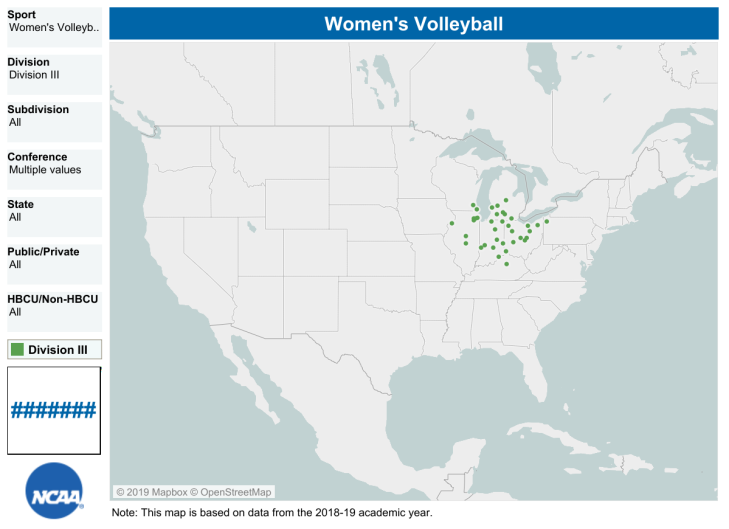
As you can see the region now stretches out a bit to the west versus what the old Great Lakes Region looked like. It has a lot of tough schools in the region and, full disclosure, I’m only now listing the schools as I write this article. (I did it all through memory so with one region done, I am already freaking out that this one is too strong.)
Region 9 is basically the Central Region with some twists and now includes American Rivers, MIAC, Upper Midwest and WIAC. I have placed Finlandia and Maranatha Baptist in this region, as well, for a total count of 40. When comparing this region with the old Central Region, I have dropped the SLIAC and removed Washington-St. Louis from the mix. This region continues to be really strong with schools like Augsburg, Bethel, Gustavus Adolphus, Saint Benedict, Saint Thomas (for a little bit anyway), Northwestern and all of the good UW teams from the WIAC. Here is the visual:
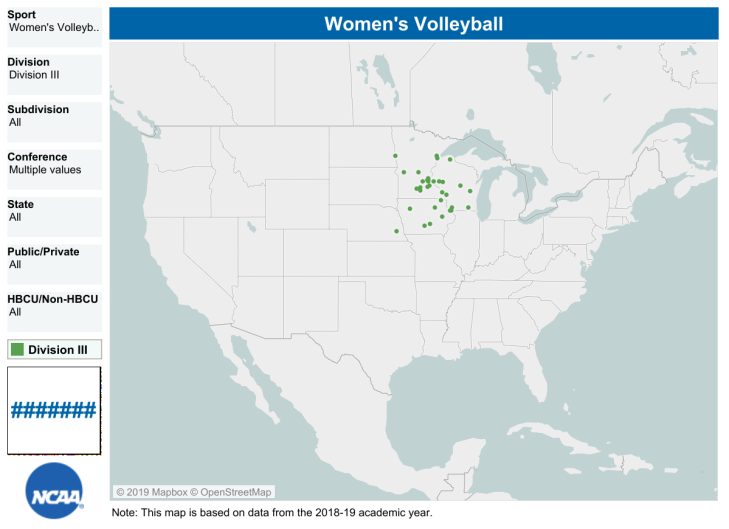
Not too shabby, right? Pretty well contained in the frozen tundra part of the country. Still, a really tough volleyball region with both the MIAC and the WIAC brought together.
Region 8 finds us moving east and picking up the rest of the Ohio conferences and stretching to the coast. This region includes NEAC, Allegheny, Presidents and OAC with independent Case Western (whoops…they are UAA) and UAA member Carnegie Mellon. This region’s count comes to 42 while pulling from three different regions – Great Lakes, Mid-Atlantic and New York. (I told you I was going to bleed off the New York Region and here is an example.) The problem with this region is that the OAC is really the only conference to provide the competitive balance with schools like Baldwin Wallace, Heidelberg, Mount Union, Muskingum, Ohio Northern and Otterbein. Carnegie Mellon is a nice addition and frankly I could have also moved Thomas More into this region although they are at the western edge of schools. Here is the visual:
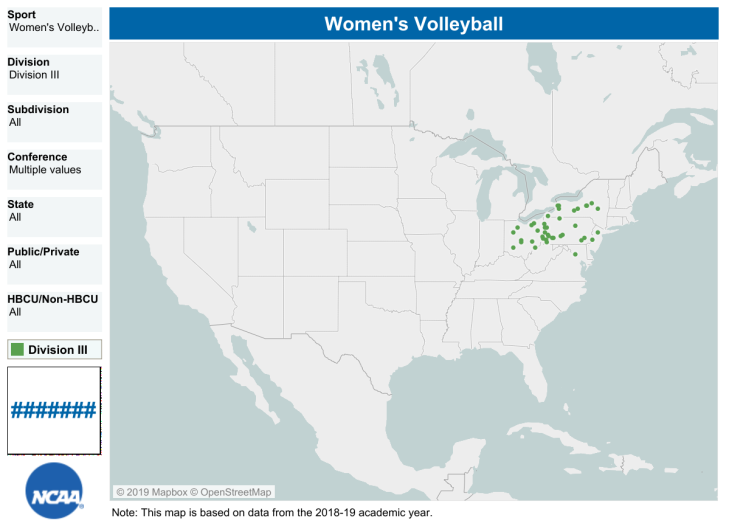
I forgot to mention that the count is at 42 with this region. Again, the easiest of the three regions so far when it comes to volleyball but we’ll have to see how the others play out before we start adjusting.
Region 7 is a mashup of the New England and New York Regions so you know the geography is going to work but the competitive balance is in trouble. This region gets CCC, MASCAC, Liberty and GNAC with UAA member Brandeis thrown in for fun. This gets their count up to 39. This region is all about Johnson & Wales (RI) and the Liberty schools (Clarkson, Ithaca, RIT and Vassar). To be fair, the CCC has had some decent teams in the past, too. Here is the visual:
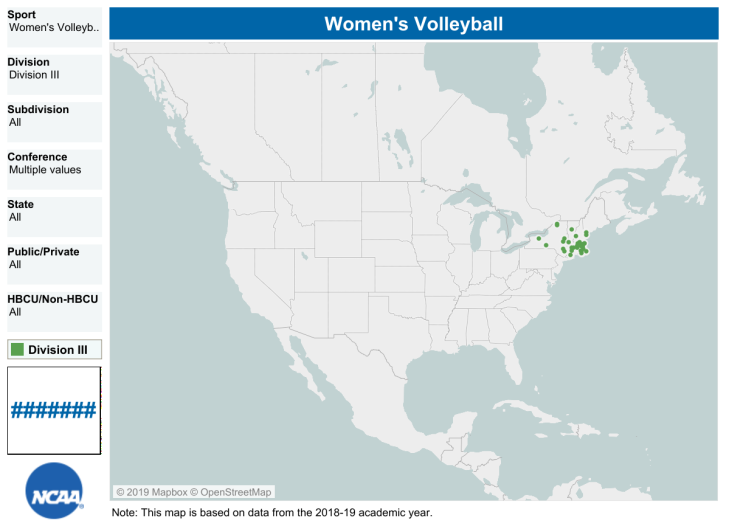
Nice and tight for the most part and this region does end up with some top end talent. I’m okay with this one.
Region 6 isn’t perfect as it stretches a bit north to south and it comes in as my smallest with 38 schools. It’s highlighted by the NEWMAC but also includes NAC, NECC and Skyline with Pine Manor thrown in, too. The NEWMAC provides Babson, MIT, Springfield and Wellesley while not much else from the other conferences. Bottom line, I needed to get Springfields’s Head Coach Moira Long on board and this should do it. (That was a joke. No, really, it was a joke. Ha ha, right?) Honestly, there is just so much anyone is going to be able to do in the northeast in this realignment. Here is the visual:

This is another New York and New England mashup and I’m guessing we may need to swap out some conferences with Region 7 or Region 5 for travel purposes. Right now, however, I don’t see a lot of ways to make this stronger without weakening other regions too much.
Region 5 is my last pure New York and New England region and comes in at 41 teams. It has Empire 8, SUNYAC, NESCAC and Little East with NYU and Rochester thrown in. The NESCAC teams will headline this region with Bowdoin, Middlebury, Tufts and Wesleyan. Stevens out of the Empire 8 have been good in the past and a SUNY school can always surprise. UMass-Boston has also been really good in the past so not a horrible region and frankly one that we may need to look at to strengthen Region 6. Here is the visual:
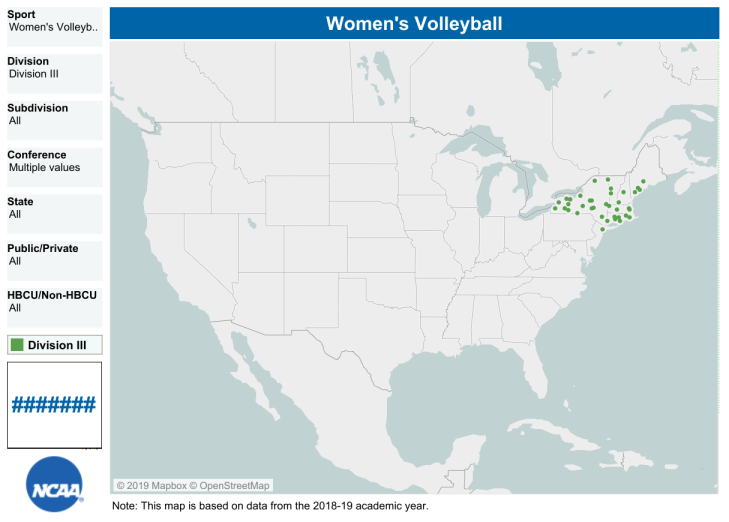
Lots of possibilities with the last three regions discussed as they overlap a lot but if the committee is going to look at competitive balance I think they will have to do something similar.
Region 4 is a slimmed down Mid-Atlantic Region as it retains Centennial, Landmark, MAC Freedom and MAC Commonwelth. I have also given them CUNYAC out of the New York Region and independents Valley Forge and Trinity (Washington). This region’s count is at 46. The top schools out of this region are Franklin & Marshall, Johns Hopkins, Muhlenberg, Swarthmore, Juniata and Susquehanna. Here is the visual:

Not the strongest region we have but also not the weakest. Juniata really makes this region what it is.
Region 3 overlaps Region 4 but stretches south. It consists of Colonial, ODAC, Atlantic East and NJAC, which means I’ve combined the Mid-Atlantic with both the South and New York Regions. The top volleyball schools are Randolph-Macon, Washington & Lee and Marymount (who loves you Coach Wilson). You also have Kean and Stockton. No top flight school to lead this region is the negative with this group that numbers 46. (Thanks Beth!!!! I forgot I also had the CAC in this region and that does give us Christopher Newport and Mary Washington. Yikes! I had them on my worksheets and they are included in the count. This region is now fine in my mind.) Here is the visual:

Another opportunity to make some adjustments but anything we want to do here would either stretch south or west. I don’t see anyway to improve the competitive balance by going north. (Stretched out, but should be good now that I remembered the CAC.)
Region 2…well, let’s hold that thought for a second. Remember I said that I’m presenting the regions in the reverse order that I worked them out. If you’ve been paying attention then you know I’m missing most of the South, all of the West and even conferences from the Midwest and Central Regions. That’s a problem but I decided that if I wanted to push conferences into the northeast so I could have more flexibility, then I needed the West Region to start shoving. I’m starting with the visual on this region:
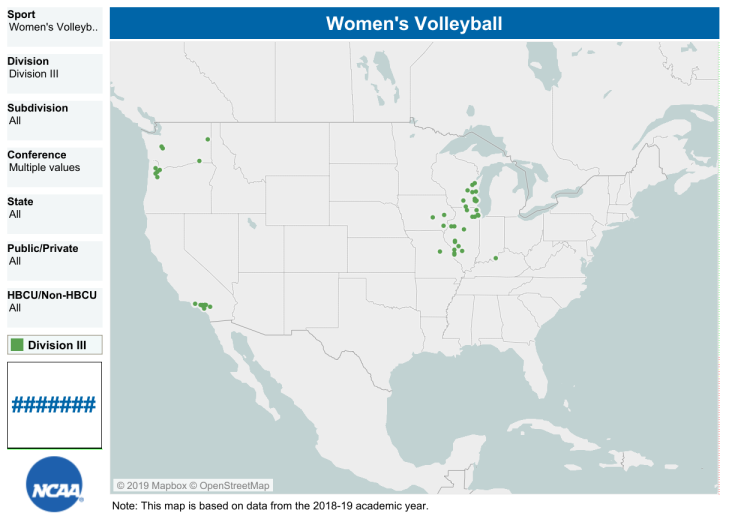
Yuck, but stay with me. This region consists of SCIAC, NWC, SLIAC, NACC and Midwest. It would also have Mills College, UC Santa Cruz and Washington-St. Louis, which brings its total to 53. My thinking here is that in order to push the South Region more north then I have to give them back the Texas schools (they were moved to the West Region earlier this decade). From the perspective of the SCIAC and the NWC, this isn’t really a big change for them as the rest of the West Region is in Texas. Instead of flying to Dallas or San Antonio, they have to go to Chicago or St. Louis. For the other conferences it’s more of a problem. I did include three conferences in this area to help them out a bit and purposely didn’t include Chicago into this mix. Top teams are CMS, Cal Lutheran, La Verne, Pacific Lutheran, Whitworth, Aurora, Concordia (WI) and Washington-St. Louis. That’s pretty strong with two of the better teams in the nation leading the way. Bottom line, if we don’t do something like this then all the committee can do is rearrange deck chairs in the midwest and the northeast areas. That approach won’t strengthen the South Region and won’t even out the West Region.
Region 1 moves the Texas schools back to the South and we are left with ASC, SCAC, SAA and USA South. Emory also goes into this region, which brings the total count to 43. I’m not 100% sure I got all of the conferences placed into a region but I think I did. This region is led by UT-Dallas, Mary Hardin-Baylor, Trinity, Colorado College, Southwestern, Berry, Birmingham-Southern and, of course, Emory. From the Texas perspective, the level of competition doesn’t change much as they get removed from the strong teams in the SCIAC (not to mention the NWC top schools) but pickup Emory and a couple of strong teams from the SAA. Here is the visual:
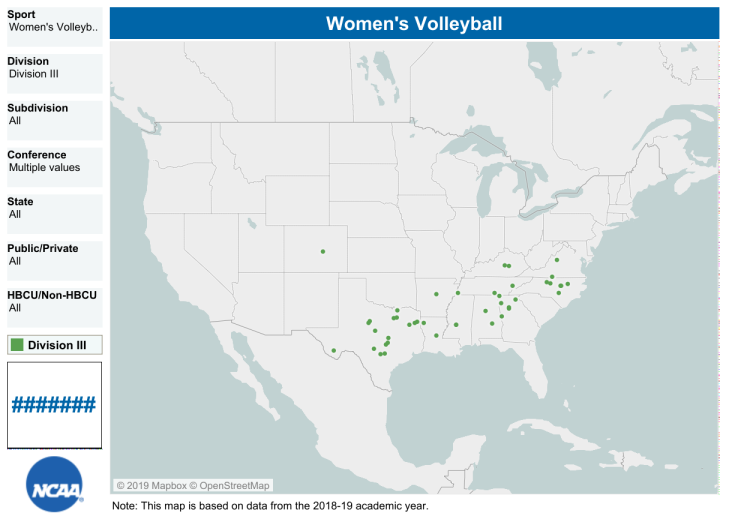
Pretty stretched out but honestly if you look at time zones this becomes easier for the Texas schools (and Belhaven University would love this). The South Region loses their northern schools but we don’t have to limit them to 3 conferences as the AVCA regional alignment does. Bottom line this is really an expanded South Region while Region 2 becomes the warped West Region.
I honestly did not write down school names as I did these regions. I did try to make all of the regions competitive but I did this through conferences more than specific schools. I did go back and make some adjustments and, as I’ve said, I think more adjustments could be done to this realignment plan. Skimming through what I’ve written, I think Regions 3 and 6 are is the biggest problems. I can see small adjustments could be made to even out the New York and New England Regions (now Regions 5, 6 and 7) but overall, unless we can fly in Chicago and Washington-St. Louis, I don’t think we can do much. Maybe if I spent more time on this I could fix Region 3. (See, it didn’t take long to fix Region 3!)
As I said at the start of this, I didn’t think that competitive balance could be achieved through realignment. Maybe I was wrong because I got pretty close but this was only based on volleyball. I truly believe that although the push back to the Realignment Committee was well meaning, I think everyone is turning a blind eye to the true problem and that’s the Selection Committee. If we can get the Selection Committee to craft better criteria (or maybe just interpret the existing criteria differently) then it really doesn’t matter what regions the teams are in. Maybe the first criterion should be common sense. Look at the at-large bids available and dole them out to the teams you think are better. Things will get fuzzy as you fill up the spots but put together a list of teams. Then go through the selection criteria but keep your original list as a sanity check. If the criteria tells you that we need 4 New England teams and 2 New York teams than dive deeper into the criteria because that shouldn’t match with your original list. Now, if your original lists includes New York teams or a lot of New England teams then maybe the battle is lost. I mean if the committees really think these are your stronger teams than the realignment is going to fail when considering competitive balance because the committee doesn’t know what competitive teams look like.
To close out this effort, I do like that the NCAA is thinking about competitive balance and that they were willing to rethink their realignment plan. This really gives me hope and that’s a feeling I don’t associate with the NCAA. I can’t wait to see where the Realignment Committee goes with this but I hope it veers more to my plan than just rearranging deck chairs.

Love what you do and thanks for the shout out! If I’m following I think you meant Capital Athletic Conference for Colonial and forgot two very strong programs – Christopher Newport and your beloved Mary Washington. Also I think Thomas Moore is officially out of d3 for 2019. If Pool B stays w 2 bids, it’s a good opportunity for the Atlantic East to get 2 teams in while we are in our 2nd provisional year.
LikeLiked by 1 person
NM. Colonial States is d3. I was thinking about my playing days in Colonial Athletic Conf.
LikeLiked by 1 person
No, you were right! I missed that the CAC was also in Region 3. It was included in my map and the count but not the write-up. I’ve made updates in the article. Thanks!!!!!
LikeLike
Yeah, Thomas More looks done. I know they announced it but then played DIII another year.
LikeLike
Good work. one minor thing that should come out of this with 10 regions, there should not be a region with 2 UAA teams (Case Western is UAA). Region 9 looks too strong. I think the NCAA will have a hard time not keeping “the islands” (NWC, SCAIC, SCAC) in the same group. Nothing they do will put a league on an airplane they don’t need to be on.
Your ending is correct. They just need to do a better job with the criteria in general. National rankings!
See my VT post on changing the AQ situation to get needed pool C bids.
LikeLiked by 1 person
I “fixed” the Case Western mistake. Not sure why you don’t want two or more UAA teams in the same region?
I had another coach point out that the men’s basketball regions are different than volleyball. I thought the regions were all the same across the sports, but I guess I was wrong. In that sport, Augsburg (CCIW) is in the West. Upper Midwest, too. Texas schools are still in the South Region. You have to remember that just because the conferences are on an island doesn’t force teams to fly within region. The SCIAC and NWC are typically going to fly out at least once. Plus the SoCal teams get at least two or three tournaments that draw schools from around the nation to their gyms.
LikeLike
Hi RR, I am on vacation and playing with this impossible puzzle a bit. I am using Pablo’s conference average rank as the numerical value to balance strength. So each region is an average of those league averages. here is what I got for your 10 regions. the UAA is not part of these averages.
Region / Leagues / count / Pablo Ave
R10 4 39 128
R9 4 40 127
R8 4 43 255
R7 4 39 274
R6 4 38 323
R5 4 41 217
R4 5 46 237
R3 5 46 261
R2 5 53 169
R1 4 43 183
43 428
LikeLiked by 1 person
Thanks for this cross-check. The New York/New England regions are 5 through 8 and as I said in the piece, there is only so much anyone is going to be able to do here. With that said, Region 5 could be used to normalize Region 6 a bit. Bottom line, we’ll probably have a mid-200 range for 6 of the regions and mid to low 100s for 4 of the regions. When you factor in the UAA teams (with most of the good teams being in the regions that are already good) it will just make things more uneven. Without creating a bunch of UAA-type conferences, I don’t see a perfect solution.
LikeLike